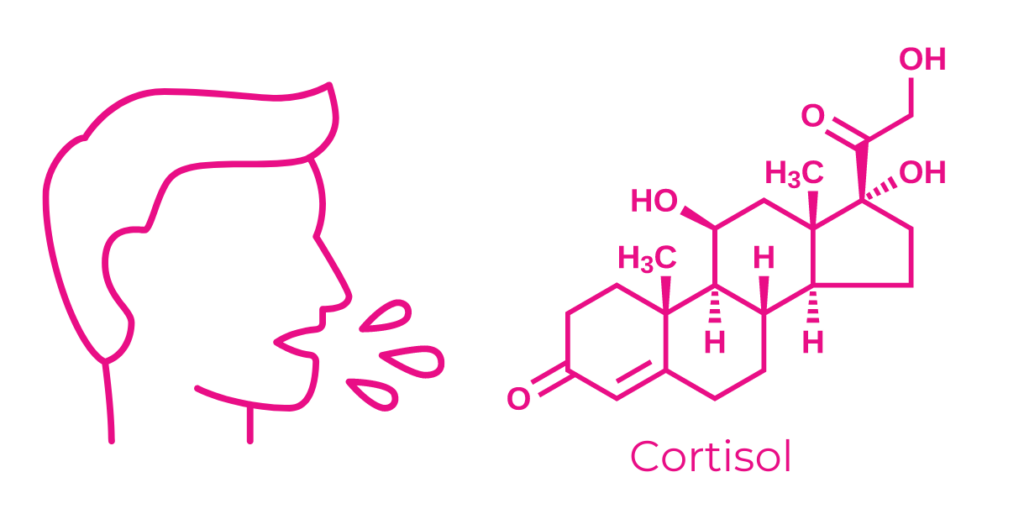Introduction
The skin is characterized by numerous aspects: its color, texture, age, homogeneity, and more. But did you know that the skin can also present an odor?
This is not to be confused with body odors like those from the armpits or feet. Indeed, the skin emanates molecules that can reflect our emotional state and play a role in our subtle communication with others.

Recent studies from Katsuyama et al, have shown that the gases emitted by our skin can vary based on physical condition and diet, attracting significant scholarly attention as a noninvasive biomarker for understanding different physical conditions. This study published in PLoS One (2022) has delved deeper into the relationship between psychological stress and skin gas, uncovering fascinating insights into how our emotions influence the odors our skin emits.
Methodology
Study Design
To investigate the relationship between psychological stress and skin gas, researchers conducted a detailed study involving 40 healthy Japanese women aged 35 to 44 years.
To ensure the accuracy of the results, participants were selected based on specific criteria, including being non-smokers to avoid any tobacco odor contaminants.

Stress-Inducing Session
Participants were subjected to a 20-minute interview with an unfamiliar interviewer, a situation confirmed to induce psychological stress through physiological indicators.

Relaxation Session
On a different day, participants spent 20 minutes relaxing in a chair and reading a magazine in a controlled environment.

.
Data Collection
Multiple types of data were collected to evaluate the impact of stress on skin gas:
– Electrocardiographic Data: Continuous monitoring of electrocardiographic activity was conducted to measure changes in the autonomic nervous system during both sessions.
– Saliva Samples: Saliva was collected three times – at baseline, after the interview, and after the relaxation session – to measure cortisol levels, a key indicator of stress.

– Skin Gas Samples: Skin gas was collected from the participants’ hands using a specialized sampling bag. Participants washed their hands with unscented soap before sampling to ensure no external odors affected the results.
Sensory Evaluation
A panel of four odor experts conducted a blind sensory evaluation of the skin gas samples collected during both the stress and relaxation sessions. The experts rated the intensity and characteristics of the odors on a five-point scale, ranging from “not smelly at all” to “very strongly smelly.”

Analysis
The gas samples were analyzed using gas chromatography-mass spectrometry (GC-MS) to identify specific compounds responsible for the odors. The main components identified were allyl mercaptan and dimethyl trisulfide, which were particularly prominent in samples collected during the stress-inducing interviews.

Résultats
Physiological Responses to Stress / Réponses Physiologiques au Stress
– Autonomic Nervous System Activity: During the stress-inducing interviews, there was a significant increase in the low-frequency to high-frequency (LF/HF) ratio, indicating heightened sympathetic nervous system activity. This confirmed that the participants were experiencing physiological stress.

– Cortisol Levels: Salivary cortisol levels were significantly higher after the stress-inducing interviews compared to the baseline and relaxation sessions, further corroborating the presence of psychological stress.
Odor Emission Under Stress
– Characteristic Odor: The skin gas samples collected during the stress-inducing interviews had a distinctive odor similar to stir-fried leeks. This odor was reproducibly detected by the panel of odor experts and was notably absent in samples collected during the relaxation sessions.
– Chemical Analysis: Gas chromatography-mass spectrometry (GC-MS) identified allyl mercaptan and dimethyl trisulfide as the main components of the characteristic stress-induced odor. These compounds were present in higher concentrations during the stress-inducing sessions compared to the relaxation sessions.

Psychological Impact on Others
Perceived Stress: When other individuals were exposed to the stress-induced odor, they reported increased feelings of tension, confusion, and fatigue, as measured by the Profile of Mood States (POMS) scale. This suggests that the odors emitted under stress can influence the emotional states of others, highlighting a potential mechanism for nonverbal communication through odor.

Discussion
The findings of this study provide intriguing insights into how our emotional states can influence the odors our skin emits and how these odors can affect those around us. The identification of specific compounds like allyl mercaptan and dimethyl trisulfide as markers of stress-induced odor opens up new avenues for research and practical applications.

Implications for Nonverbal Communication
The study supports the idea that human body odors can serve as a form of nonverbal communication, conveying information about our emotional states to others. This can have implications in various fields, from enhancing social interactions to developing new diagnostic tools for stress and emotional well-being.

Potential Applications
– Diagnostic Tools: The identification of specific stress-related odors could lead to the development of noninvasive diagnostic tools for assessing psychological stress and emotional health.
– Product Development: The cosmetic and personal care industries could leverage these findings to create products that help manage or mask stress-induced odors, improving personal comfort and social interactions.

Conclusion
The study published in PLoS One by Katsuyama et al. sheds light on the fascinating relationship between psychological stress and skin gas. By revealing how our emotional states can alter the odors our skin emits and how these odors can impact others, the research opens up new possibilities for understanding human interaction and developing innovative applications in health and wellness.

Contact us to discuss your projects.
reference
Katsuyama M, Narita T, Nakashima M, Kusaba K, Ochiai M, Kunizawa N, Kawaraya A, Kuwahara Y, Horiuchi M, Nakamoto K. How emotional changes affect skin odor and its impact on others. PLoS One. 2022 Jun 30;17(6):e0270457. doi: 10.1371/journal.pone.0270457. PMID: 35771844; PMCID: PMC9246182.



